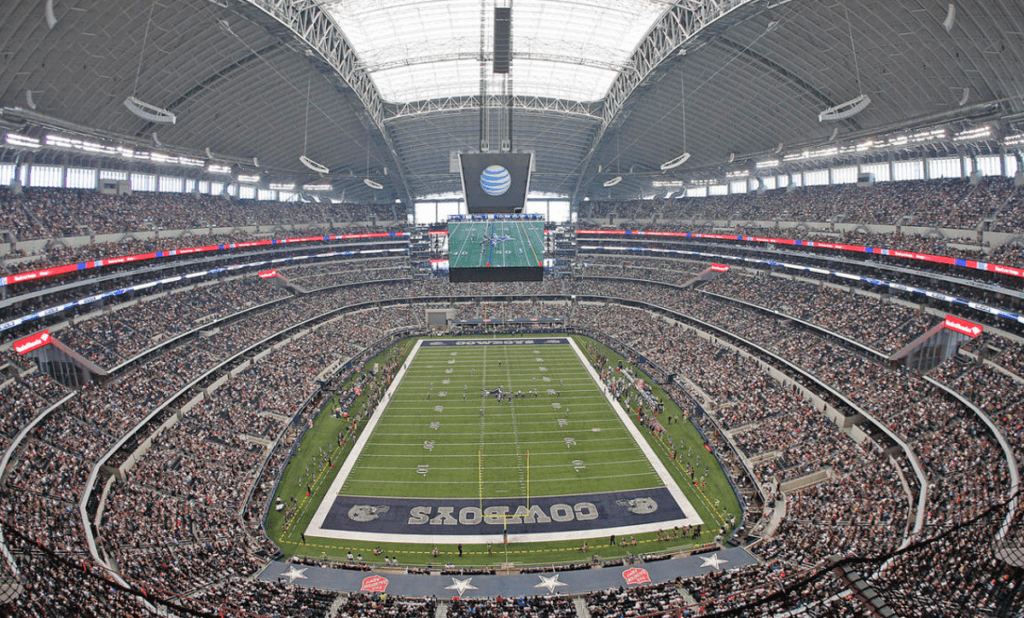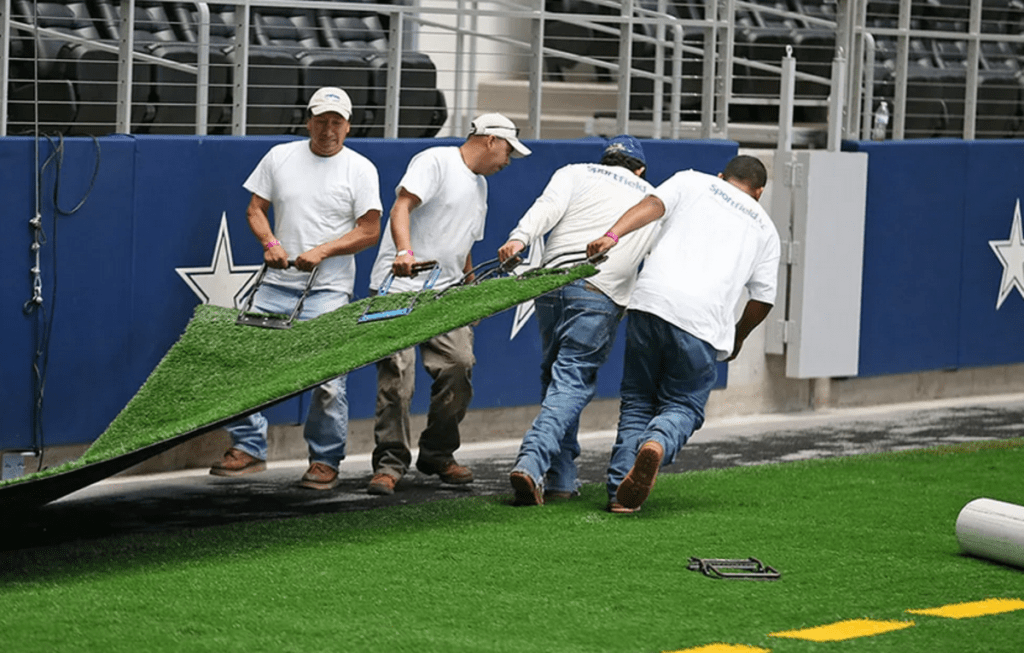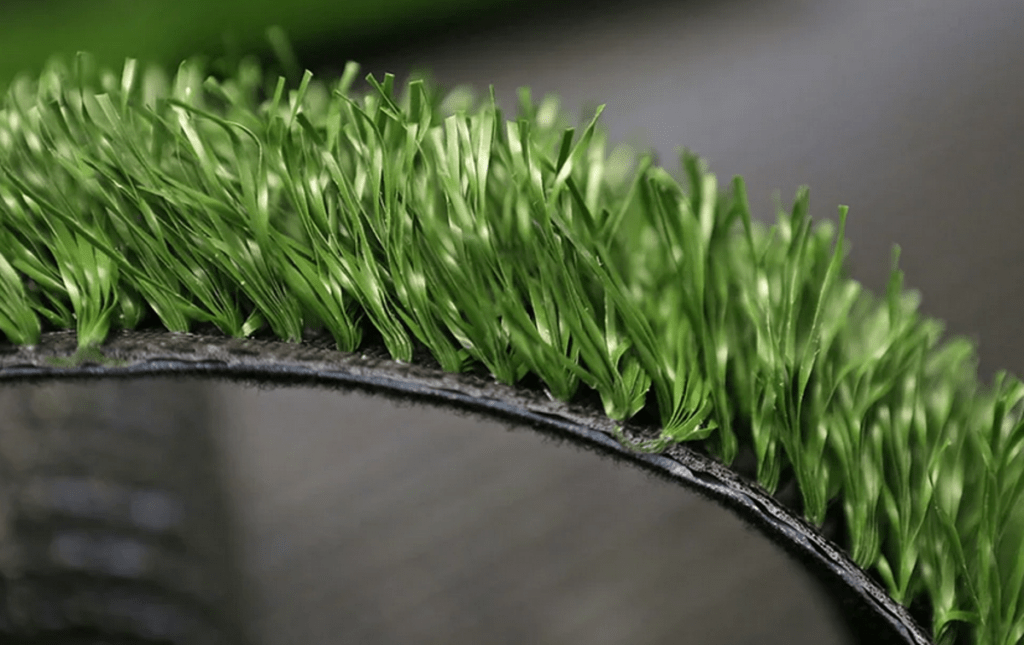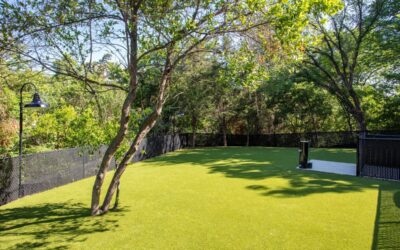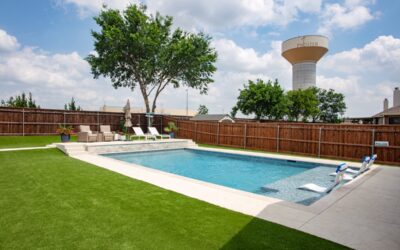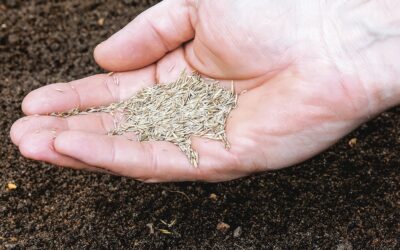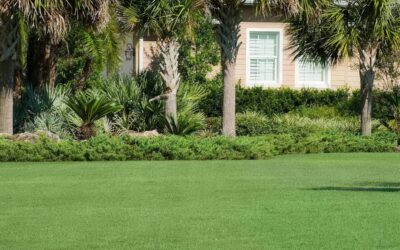Most NFL fans know the AT&T Stadium is home to the Dallas Cowboys but are the games held on turf or grass?
It’s a question asked by many sports enthusiasts as NFL franchise owners, players and commentators alike weigh up the pros and cons of artificial turf vs. natural grass playing fields.
Like 14 other stadiums in the NFL (used by 16 teams in total), the AT&T Stadium has artificial grass installed as its playing surface. This grass is made by a company called Hellas Construction and it is manufactured right here in Texas.
Here’s what else you need to know about the artificial turf at the AT&T Stadium and the main pros and cons of turf and grass…
AT&T Stadium: Brief history
Completed in 2009, the home of the Dallas Cowboys in Arington is one of the most expensively constructed stadiums in the world — over one billion dollars was spent on it. It’s also one of the largest with an NFL capacity of 80,000.
The AT&T (formerly the Cowboys Stadium) replaced Texas Stadium, which was the Cowboys’ home from 1971 until the end of the 2008 season.
The stadium is domed with a retractable roof and plays host to other events besides Cowboys games, such as the Cotton Bowl Classic, the Big 12 Championship Game and the Southwest Classic. It also hosts concerts, basketball, soccer, college and high school football contests, as well as rodeos and professional wrestling competitions.
The AT&T has always had artificial grass as its football playing surface but several different installations have appeared since 2009. Here are some photos of the latest turf installation at the AT&T.
When grass is required for events, the stadium design allows it. For instance, as one of the eleven U.S. venues selected to host matches during the 2026 FIFA World Cup, the AT&T Stadium will need to temporarily install a hybrid of grass and synthetic turf for the tournament. To meet FIFA regulations for field size, the soccer pitch will be on a raised platform 15 feet above the level of the NFL football field.
What type of artificial turf is used at AT&T?
The most recent turf installation of the playing surface for Cowboys games includes artificial grass manufactured right here in Texas
This is Hellas Matrix Turf with a Helix Soft Top (explained below). Hellas Construction Inc. is headquartered in Austin, Texas and is America’s largest sports surfacing contractor, with three manufacturing facilities across the country.
The turf itself was the first system developed with two different-sized fibers in two different shades of green. This provided both the performance and the appearance that the Cowboys were looking for, with the look and feel of a natural grass field.
The combination of the turf fibers and selected infill provides a surface with increased control and footing, impact reduction, shock absorbency, traction and slip resistance. These are key benefits at a time when the safety of artificial grass for NFL games is being scrutinized.
Downtime of the field system due to the weather is minimized by reduced “fly-out” and splashing after heavy rainfall.
The turf used at the AT&T stadium is made by the same manufacturer as that used at the NRG Stadium (home of the Houston Texans) and the two L.A. teams (the Rams and the Chargers), who play at the SoFi stadium.
Other notable installations of Hellas Matrix turf include Idaho State University (Holt Arena) and Eastern Illinois University.
What is the Soft Top design at the AT&T?
The Soft Top filed conversion system employed at the AT&T Stadium allows the facility to switch between a variety of events to maximize venue revenues.
The system employs 26 interchangeable panels so that the stadium’s turf field can be installed and removed in only 12 hours. This provides great flexibility for hosting a variety of events besides football games, such as live concerts and soccer matches.
Remember, at a record construction cost of over a billion dollars, the AT&T wants to maximize its revenues from events besides Cowboys matches — and this turf design helps them do it.
Artificial turf and injuries
There have long been heated discussions in the NFL about which surface is best: turf or natural grass.
In recent years, as more stadiums have made the switch to artificial turf, the media spotlight on player injuries has intensified.
Some players have voiced their support for grass fields over turf fields. But artificial grass also has its fervent supporters. The longtime owner of the Dallas Cowboys, Jerry Jones, is one of them, alluding to the lack of issues they’ve encountered with artificial turf and the many benefits of its low-maintenance qualities.
It’s fair to say that grass fields are favored by more players than their turf counterparts. The NFL Players Association (NFLPA) recently announced that data for the 2022 regular season shows that noncontact injuries for players occurred at a higher rate on artificial turf compared to grass.
This bucked the trend from the previous year when the injury statistics were approximately even on the two surfaces.
And Jerry Jones has this to say about safety:
“Our league stats don’t see issues with the type surface that we have as opposed to natural grass. We don’t see issues. No facts bear that out.”
It’s also worth noting that one of the most recent NFL converts to artificial turf, the Nissan Stadium (home of the Tennessee Titans), made the switch because of the notoriously inconsistent natural grass playing surface. Titans president and CEO, Burke Nihill said:
“We’ve had a lot of issues (with the grass at Nissan Stadium) after a certain part of the season. It’s hard to grow grass. It gets slick. We put new turf down, we try and put new sod down and it’s slick, you see guys slipping. Those are real things that I’ve witnessed over my time here.”
For many NFL franchise owners, the high maintenance costs of grass, especially during the wetter and colder times of the year, are often prohibitively high, meaning that they favor turf.
According to this ESPN report, the NFL and NFLPA are working with field managers to optimize care for the turf and, with turf field installations generally being replaced or upgraded every few years, the latest and safest technologies can be employed to ensure player safety.
Turf vs. grass at NFL stadiums
If the split between NFL stadiums with grass/turf is anything to go by, the turf vs. grass debate is a fairly even one.
The Cowboys are one of 17 NFL teams at 15 stadiums around the country to play on artificial grass home fields — compared with 13 teams on grass and two on hybrid fields.
There are pros and cons of each surface and these are detailed below:
Main pros of artificial turf
- Very low maintenance
- Highly cost-effective
- Natural look and appearance all year round
- Weather resistant (rain, sun, ice and snow)
- Increased playing time (fewer weather interruptions)
- Highly durable
- Drains well
- Little water required
- Few chemicals used
- No mud
Main cons of artificial turf
- Higher installation price
- Some players prefer natural grass
- Some negative stigma remains about turf
- Requires infill, which may contain chemicals
- Hotter than grass
Main pros of real grass
- Looks natural and lush when well-kept
- Gives out oxygen and filters pollution
- Absorbs heat well
- Absorbs moderate rainfall well
- Generally good traction
- Cushioned feel
Main cons of real grass
- Sodding required
- High maintenance with mowing, edging, aeration, weed control, watering, etc.
- Sprinkler system and irrigation required
- Compaction and bare spots may occur
- Muddy in wet weather
- Heavy rainfall may lead to standing water
- May be damaged by icy conditions
Artificial turf is going nowhere at the AT&T
With the Cowboys owner such a staunch defender of artificial turf, you can expect to see turf on the game field surface at the AT&T for many years to come.
Many professional and amateur sports fields across Texas are following suit and switching from real grass. The chief benefits of low maintenance/water usage, a year-round immaculate appearance and cost-effectiveness make high-quality, durable synthetic turf a logical choice in high-use commercial areas such as sports fields.If you’re in the Dallas-Fort Worth area and are considering artificial turf for football, soccer or any other indoor or outdoor sport, speak with one of our artificial grass professionals to check your options.

